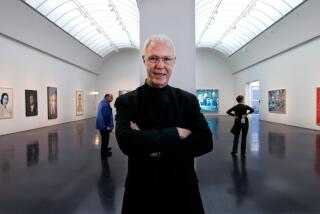Gifford Phillips dies at 94; contemporary art advocate
Gifford Phillips, a gentlemanly patron of cultural institutions and passionate advocate of contemporary art who played a leading role at museums on both coasts of the United States, has died. He was 94.
Phillips died Wednesday of natural causes at a hospice in Palm Desert, said his daughter Marjorie Elliott.
A member of a wealthy family — including his uncle, art collector Duncan Phillips, who founded the Phillips Collection in Washington, D.C. — Gifford Phillips was a partner in Pardee Phillips, a real estate developer of residential and commercial property in California and Nevada. Soft-spoken and well-educated, he lived a life of privilege, but engaged in public service as a trustee of art museums and a supporter of liberal political causes.
“Gifford used his privilege to share his love of art with people who didn’t have the same advantages,” said Stanley Grinstein, a former trustee at the Los Angeles County Museum of Art who built a large contemporary art collection with his wife, architect Elyse Grinstein. “He was a pure art lover who wanted the world to appreciate art as he did. If you were interested, he would take you to the next level. He was very important to Los Angeles in the days when there wasn’t much of an art scene here.”
As the founding chair of LACMA’s Contemporary Art Council — launched in 1961 and now called the Modern and Contemporary Art Council — Phillips led the nation’s first support group of contemporary art, said Stephanie Barron, senior curator of modern art at the museum. Although he and his wife, Joann, lived in New York and Santa Fe, N.M., as well as California, and he was a trustee at East Coast institutions, including the Museum of Modern Art in New York and Yale University Art Gallery in New Haven, Conn., he maintained ties to Southern California.
“Gifford was a life-long advocate for Los Angeles artists Richard Diebenkorn, Emerson Woelffer, Ken Price and Lee Mullican, and counted them among his friends,” Barron said.
In the early 1970s, Phillips also played what he called “an important if somewhat reluctant part” in the transformation of the Pasadena Art Museum into the Norton Simon Museum. In his 1996 memoir, “Depending on the Rich: The Collapse and Takeover of an Art Museum,” Phillips recalled a painful period when “arguably the finest museum of contemporary art in the United States” ran out of funds, “came perilously close to having to close its doors for good and was rescued only at the eleventh hour” by industrialist Norton Simon.
To the dismay of many artists and supporters of the defunct showcase, Simon changed the name of the museum and used most of the galleries to display his distinguished holdings of art made in earlier periods. The Simon museum has become one of Southern California’s cultural jewels, and some of the Pasadena Art Museum’s backers eventually found a home at Los Angeles’ fledgling Museum of Contemporary Art. But for Phillips, the failure of Pasadena’s contemporary art museum pointed out the vulnerability of cultural organizations and a chronic need for more government support of the arts.
“In this sad state of affairs,” he concluded in the memoir, “cultural institutions may end up being more dependent than ever on the generosity of well-to-do donors. We can hope that their ongoing generosity is matched by good judgment.”
Born June 30, 1918, in Chevy Chase, Md., Phillips was the son of James Laughlin Phillips, heir to a steel fortune, and Alice Conyngham Gifford Phillips. James died when Gifford was a baby. Alice later married Charles Alfred Johnson, a Colorado real estate magnate. The couple raised Gifford and his younger brother, Charles Johnson, in a castle-like residence near Denver.
Gifford Phillips began his college education at Stanford University and transferred to Yale, graduating in 1943. In recollections of turning points in his early life, he recalled donating a painting by Paul Cezanne to the Phillips Collection in memory of his father, at his uncle’s behest. He was also proud of choosing his own political path, when he decided to back Democratic presidential candidate Harry Truman instead of adhering to his family’s Republican allegiance. He met his wife, Joann Kocher, at a Democratic Party event and married her in 1953.
Among his political activities, Phillips was a California delegate to Democratic national conventions in the 1950s and 1960s. He was treasurer of Eugene McCarthy’s and George McGovern’s California presidential campaigns.
As an art collector, Phillips came of age with the Abstract Expressionists and eagerly followed the careers of Diebenkorn and other contemporary artists. In his later years, while living in Santa Fe, he became involved in the preservation of Pueblo Indian art.
In addition to his wife, Phillips is survived by his son, James, of La Quinta; daughters Alice Swistel of New York City and Marjorie Elliott of Princeton, N.J.; and eight grandchildren.
More to Read
Start your day right
Sign up for Essential California for the L.A. Times biggest news, features and recommendations in your inbox six days a week.
You may occasionally receive promotional content from the Los Angeles Times.






